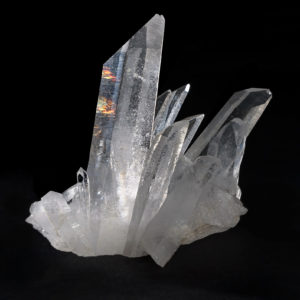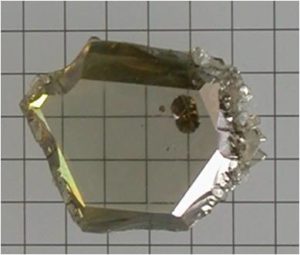
There are some crystals that we are all familiar with. Look at an analogue clock (you may need a screwdriver and/or a hammer, and the watch owner might not be too happy) and you will probably find quartz – a crystal with silicon and oxygen arranged in a well-ordered three dimensional pattern. We can also describe quartz as silicon dioxide, which describes its chemistry – one silicon for every two oxygen. Another crystal you may not know, but you may well have in your possession, is gallium nitride – made of gallium and nitrogen bonded together into a rigid network. This crystal is the key to blue LEDs, the final piece in the red-green-blue puzzle that is necessary to make white light. This discovery was so important that it led to a Nobel prize.
So silicon dioxide is also known as quartz (or maybe cristobalite, coesite or tridymite depending on its exact structure), but what is gallium nitride also known as? Unfortunately, nothing. This is because it is a crystal, but not a mineral, and only minerals can be named (officially at least – feel free to name any crystal you like and see if it catches on). The difference? Nature. In the laboratory, we can (and do, frequently) mix together different chemicals, maybe heat them up and squeeze them, and form weird and wonderful crystals. Only when this happens naturally do these crystals get elevated to the status of minerals, and as such, get their name. Since silicon dioxide is found in nature, it’s deemed a mineral (of quartz it is!), while gallium nitride is man-made, so is not given this honour.
There are basically two requirements for a crystal to become a mineral – it has to be substantially different from already existing minerals, and it has to exist in nature (which includes other planets, moons, meteorites and so on) and not be man-made. The last point is a tricky one. Imagine, for instance, a crystal that forms during a forest fire that has been ignited by a person. The crystal is more-or-less natural, but the cause of the fire was not. Is this a mineral?

Quartz, or silicon dioxide. CC BY-SA 2.5 license. JJ Harrison (https://www.jjharrison.com.au/) via wikipedia.org
Luckily, there is a panel of forty-something mineralogists who make these complex decisions for us. Based on exactly no evidence, I imagine it looks something like the way in which new popes are chosen, where they all gather in the tallest tower of a natural history museum, and a puff of smoke emerges when the new mineral has its name. Or maybe they use skype.
So let’s say you have your new mineral, it ticks all the boxes. Planning on naming it after yourself? Unfortunately, there is an inbuilt narcissism check- this generally isn’t allowed. Naming it after a company is frowned upon, but still apparently possible, so ample opportunity for sponsorship (maybe there is some money to be made selling the rights to googleite, mcdonaldsite?). If you want to name it after someone famous that’s OK, just take out the spaces between their names. So go ahead with donaldjtrumpite, for his outstanding services to science (hmmm).
Information without wild speculation is available here. Happy new-mineral hunting!


Mattia Pistone
Interesting and very entertaining blog!